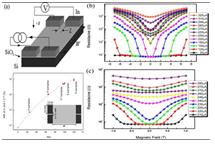Professor Zhang Xiaozhong of the Department of Materials Science and Engineering, Tsinghua University and his PhD student Wan Caihua published a paper entitled “Geometrical enhancement of low-field magnetoresistance in silicon” in Nature on September 15, 2011. Zhang and Wan are the corresponding and first authors, respectively. This research work was carried out independently by Professor Zhang’s group and is the first time that a paper has been published in Nature or Science in the field of magnetoresistance with a Chinese institution as the first listed institution.


Inhomogeneity-induced magnetoresistance (IMR), reported in some non-magnetic semiconductors, particularly silicon, has triggered considerable interest owing to the large magnitude of the effect and its linear field dependence. Theories of this effect implicate spatial variation of the carrier mobility as being responsible for IMR. Prof. Zhang’s group showed that IMR in lightly doped n-type silicon can be significantly enhanced through hole injection, and then tuned by an applied current so that it occurs at low magnetic fields. In addition they designed an IMR device where the 'inhomogeneity' is provided by the p-n boundary formed between regions where conduction is dominated by the holes and electrons respectively: application of a magnetic field distorts the current in the boundary region, resulting in large IMR. This IMR device has a room-temperature magnetoresistance, reaching 10% at 0.07 T and 100% at 0.2 T, which approaches the performance of the commercial giant magnetoresistance devices widely used nowadays in the computer industry. This new silicon based IMR device can work both in low and high magnetic fields and is therefore also attractive to the magnetic field sensing industry. Moreover, because the device is based on a conventional silicon platform, it should be possible to integrate it with existing silicon devices thereby aiding the development of silicon-based magnetoelectronics.
